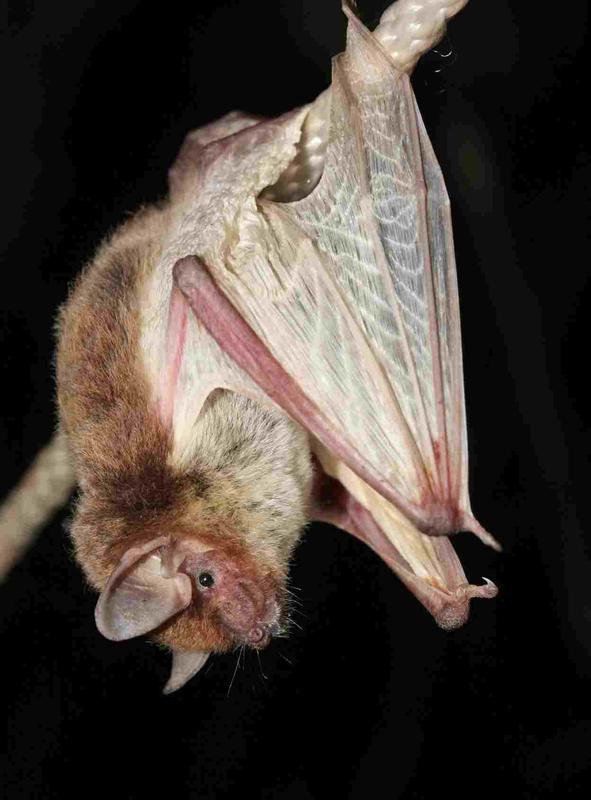An Attractive new Bat Species from West Africa

Isabelline White-winged Serotine bat (Neoromicia isabella) from the Simandou-Mountains in Guinea (Photo: © Jan Decher 2008)
During research on the small mammal diversity in the West African country of Guinea, mammalogist Dr. Jan Decher from the Zoological Research Museum Alexander Koenig – Leibniz Institute for Animal Biodiversityin Bonn and his team discovered an attractive small bat, which will have the scientific name Neoromicia isabella in future, or Isabelline White-winged Serotine in English.
The tiny bat has a body length of 4-5 cm and weighs about 5 grams. Flight membranes, tail membrane and the fur of the belly are colored white; the ears, lips and feet are also almost white. In contrast, the hairs on the back are isabella-coloured, that is light orange-brown.
This unique contrasting colouration differs from all other species occurring in West Africa. Genetic studies carried out in the Centre for Molecular Biodiversity at Museum Koenig support its status as a new species.
Between 2008 and 2012 researcher from Germany, The United States and Swaziland discovered the Isabelline White-winged Serotine during environmental impact assessments in the Simandou and Nimba Mountains of southeastern Guinea.
The species occurs in relatively undisturbed rainforest areas that are part of iron ore mining concessions awarded to international mining companies. The biological surveys were designed to assess which rare animal and plant species occur on the mountains and provide data for planning the mining operation as environmentally sustainable as possible.
In the Simandou Mountains 35 bat species were found. Species richness estimations showed that up to 45 bat species may occur there. Thus, the Simandou Mountains are one of the regions with the most diverse bat fauna in Africa.
Contact:
Dr. Jan Decher
Zoologisches Forschungsmuseum Alexander Koenig
Adenauerallee 160, D-53113 Bonn, Germany
Phone: +49 228 9122262
E-mail: j.decher@zfmk.de
Source:
Decher, J., Hoffmann, A., Schaer, J., Norris, R.W., Kadjo, B., Astrin, J., Monadjem, A., Hutterer, R. 2016. Bat diversity in the Simandou Mountain Range of Guinea, with the description of a new white-winged vespertilionid. Acta Chiropterologica 17(2): 255-282 (for 2015)
doi: http://www.bioone.org/doi/full/10.3161/15081109ACC2015.17.2.003
The Zoological Research Museum Alexander Koenig (ZFMK) and Leibniz Institute for Animal Biodiversity is one of the largest natural-history-research museums in Germany. The museum has earned its reputation as a leader in the documentation, research, and interpretation of biodiversity.
The Leibniz Association is a network of 89 scientifically, legally and economically independent research institutes and scientific service facilities. Leibniz Institutes perform strategic- and thematically-oriented research and offer scientific service of national significance while striving to find scientific solutions for major social challenges.
http://www.bioone.org/doi/full/10.3161/15081109ACC2015.17.2.003
Media Contact
More Information:
http://www.zfmk.deAll latest news from the category: Life Sciences and Chemistry
Articles and reports from the Life Sciences and chemistry area deal with applied and basic research into modern biology, chemistry and human medicine.
Valuable information can be found on a range of life sciences fields including bacteriology, biochemistry, bionics, bioinformatics, biophysics, biotechnology, genetics, geobotany, human biology, marine biology, microbiology, molecular biology, cellular biology, zoology, bioinorganic chemistry, microchemistry and environmental chemistry.
Newest articles

Bringing bio-inspired robots to life
Nebraska researcher Eric Markvicka gets NSF CAREER Award to pursue manufacture of novel materials for soft robotics and stretchable electronics. Engineers are increasingly eager to develop robots that mimic the…

Bella moths use poison to attract mates
Scientists are closer to finding out how. Pyrrolizidine alkaloids are as bitter and toxic as they are hard to pronounce. They’re produced by several different types of plants and are…

AI tool creates ‘synthetic’ images of cells
…for enhanced microscopy analysis. Observing individual cells through microscopes can reveal a range of important cell biological phenomena that frequently play a role in human diseases, but the process of…





















